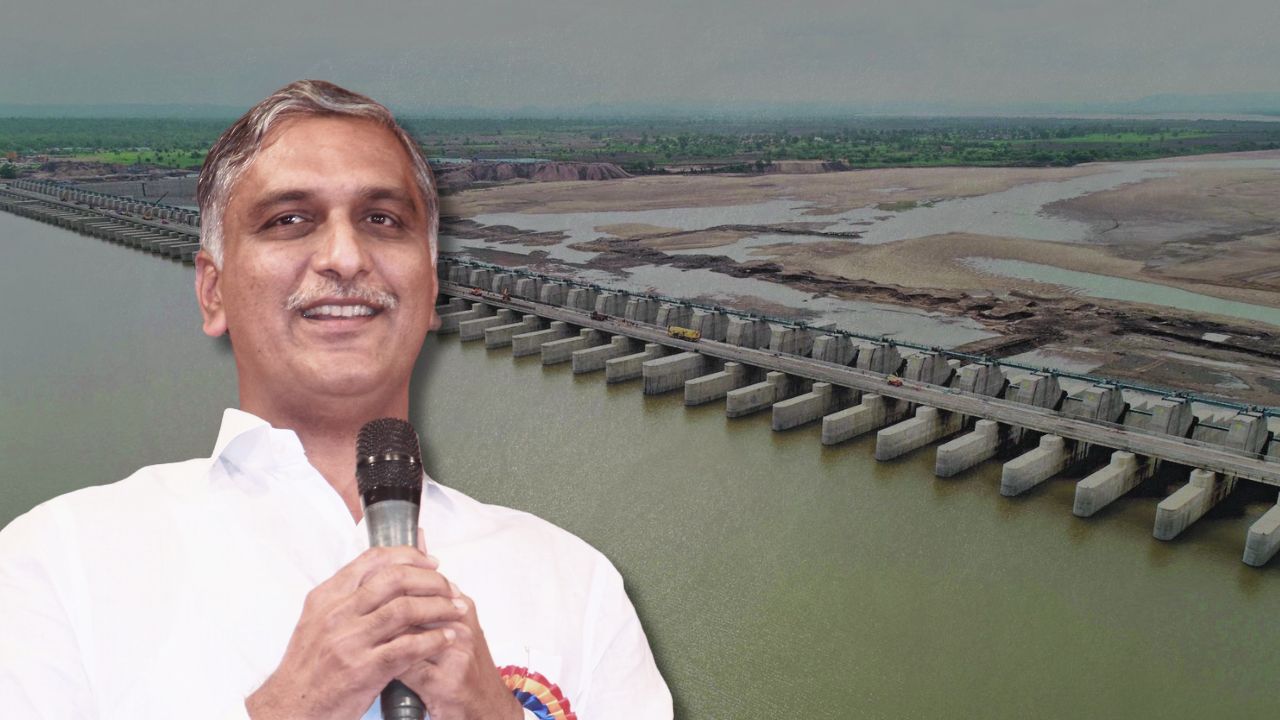The commission questioned Harish Rao about the decision to shift the site from Tummidi Hatti in Adilabad district to Medigadda in Jayashankar Bhupalpally district.
Published Jun 09, 2025 | 4:29 PM ⚊ Updated Jun 09, 2025 | 4:29 PM

Rao alleged that the Congress, despite being in power at the Centre, in Maharashtra, and in undivided Andhra Pradesh for seven years, failed to secure the necessary clearances for the Tummidi Hatti site.
Synopsis: Former BRS minister T Harish Rao appeared before the Justice PC Ghose Commission in Hyderabad on Monday, defending the decision to shift the Kaleshwaram Lift Irrigation Scheme site from Tummidi Hatti to Medigadda. He submitted cabinet resolutions and technical reports to support the move, emphasising that all necessary approvals were secured and that the project remains a vital lifeline for Telangana.
The decision to relocate the Kaleshwaram Lift Irrigation Scheme (KLIS) from Tummidi Hatti to Medigadda was a central point in the deposition of former BRS Minister and Siddipet MLA T Harish Rao before the Justice PC Ghose Commission in Hyderabad on Monday, 9 June.
Speaking to the media after his appearance before the commission – currently probing alleged irregularities in the execution of the project – at BRK Bhavan, Rao, who earlier served as Irrigation Minister in the BRS government, defended the decision, describing KLIS as the “lifeline of Telangana.”
Rao’s appearance follows that of Malkajgiri BJP MP Eatala Rajender, who served as Finance Minister in the first BRS regime, on 7 June.
He told the commission that the project’s construction was based on cabinet decisions and reiterated his demand for the probe’s findings to be made public.
Former Chief Minister and BRS supremo K Chandrasekhar Rao is scheduled to appear before the commission on 11 June.
The Kaleshwaram Lift Irrigation Scheme, a flagship initiative of the previous BRS administration, was conceived to meet irrigation and drinking water needs across Telangana.
However, allegations of inflated project costs, structural failures – such as damage to the Medigadda barrage – and financial irregularities have led to a comprehensive judicial probe that remains ongoing.
As part of its inquiry, the commission questioned Harish Rao about the decision to shift the site from Tummidi Hatti in Adilabad district to Medigadda in Jayashankar Bhupalpally district.
Rao told the commission that the original site faced objections from Maharashtra over submergence concerns, while Medigadda was identified as a more suitable option due to better water availability.
He submitted cabinet resolutions, WAPCOS reports, and letters from the Central Water Commission (CWC) in support of the decision.
He pointed out that the Pranahita-Chevella project had originally been proposed by the previous Congress government in the then undivided Andhra Pradesh, split into seven packages with 27 tenders floated – though core construction work was never initiated.
Maharashtra’s then Irrigation Minister, Hasan Mushrif, had reportedly objected to the proposed 152-metre height at Tummidi Hatti, citing the risk of submergence in his state.
Despite multiple meetings, both Congress and BJP-led governments in Maharashtra refused to grant clearance, Rao said.
He added that the CWC had flagged concerns over inadequate water availability and limited reservoir capacity, which prompted a search for an alternative location.
Following a WAPCOS survey, Medigadda was selected, and the project was subsequently constructed there.
Rao further alleged that the Congress, despite being in power at the Centre, in Maharashtra, and in undivided Andhra Pradesh for seven years, failed to secure the necessary clearances for the Tummidi Hatti site.
Rejecting allegations of failure, Rao said the Kaleshwaram project comprises over 100 components – including barrages, reservoirs, pump houses, and canals – all of which remain operational.
He said Mallanna Sagar, a part of KLIS, supplies water to Hyderabad’s Musi River project and for drinking water needs, yet critics continue to unfairly label it “Kooleshwaram” (collapsed project).
Rao maintained that the Kaleshwaram Corporation had obtained all the required approvals and presented documentary evidence before the commission.
He also clarified that changes to the locations of the Annaram and Sundilla barrages were technical decisions based on engineering surveys – a standard practice in large-scale infrastructure projects.
(Edited by Dese Gowda)
